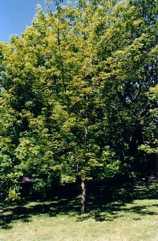Silver maple

It is a temperate plant. It is native to E North America. It does best in moist well drained soils. They can tolerate some flooding. It cannot tolerate much shade. It suits hardiness zones 4-8. Arboretum Tasmania.
Also known as:
River maple, Soft maple, White maple
Synonyms
- Acer dasycarpum Ehrh.
- Acer eriocarpum Michx.
- and several others
Edible Portion
- Seeds, Leaves, Sap, Bark
Where does Silver maple grow?
Found in: Asia, Australia, Canada, Europe, Korea, North America, Tasmania, Turkey, United States
Notes: There are about 120-150 Acer species.
Growing Silver maple
Cultivation: Seed should be pre-soaked for 24 hours then kept cold at 0-8°C for 2-4 months to assist them to grown. Seed can be sown fresh if green seeds are used. Layering or cuttings can be used. Stem cuttings shoot easily.
Edible Uses: The sap of the tree is used as a source of sugar. The inner bark can be cooked, dried, ground into flour then used to thicken soups. The leaves of self sown seedlings can be eaten fresh. The seeds with the wings removed can be boiled and eaten.
Production: Trees are fast growing but only last 125 to 140 years.
Nutrition Info
per 100g edible portion| Edible Part | Energy (kcal) | Protein (g) | Iron (mg) | Vitamin A (ug) | Vitamin c (mg) | Zinc (mg) | % Water |
|---|---|---|---|---|---|---|---|
| Seeds | - | - | - | - | - | - | |
| Sap | - | - | - | - | - | - | |
| Leaves | - | - | - | - | - | - | |
| Bark | - | - | - | - | - | - |
Silver maple Photos


References
Beckstrom-Sternberg, Stephen M., and James A. Duke. "The Foodplant Database." http://probe.nalusda.gov:8300/cgi-bin/browse/foodplantdb.(ACEDB version 4.0 - data version July 1994)
Bircher, A. G. & Bircher, W. H., 2000, Encyclopedia of Fruit Trees and Edible Flowering Plants in Egypt and the Subtropics. AUC Press. p 6
Bodkin, F., 1991, Encyclopedia Botanica. Cornstalk publishing, p 43
Brickell, C. (Ed.), 1999, The Royal Horticultural Society A-Z Encyclopedia of Garden Plants. Convent Garden Books. p 68
Brouk, B., 1975, Plants Consumed by Man. Academic Press, London. p 249
Coombes, A.J., 2000, Trees. Dorling Kindersley Handbooks. p 101
Cundall, P., (ed.), 2004, Gardening Australia: flora: the gardener's bible. ABC Books. p 89
Etherington, K., & Imwold, D., (Eds), 2001, Botanica's Trees & Shrubs. The illustrated A-Z of over 8500 trees and shrubs. Random House, Australia. p 70
Farrar, J.L., 1995, Trees of the Northern United States and Canada. Iowa State University press/Ames p 142
Harris, E & J., 1983, Field Guide to the Trees and Shrubs of Britain. Reader's Digest. p 133
Hedrick, U.P., 1919, (Ed.), Sturtevant's edible plants of the world. p 21 (Also as Acer dasycarpum)
Joyce, D., 1998, The Garden Plant Selector. Ryland, Peters and Small. p 106
Little, E.L., 1980, National Audubon Society Field Guide to North American Trees. Alfred A. Knopf. p 578
Lyle, S., 2006, Discovering fruit and nuts. Land Links. p 46
MacKinnon, A., et al, 2009, Edible & Medicinal Plants of Canada. Lone Pine. p 66
Plants for a Future database, The Field, Penpol, Lostwithiel, Cornwall, PL22 0NG, UK. http://www.scs.leeds.ac.uk/pfaf/
Sp. pl. 2:1055. 1753
World Checklist of Useful Plant Species 2020. Royal Botanic Gardens, Kew
Young, J., (Ed.), 2001, Botanica's Pocket Trees and Shrubs. Random House. p 64